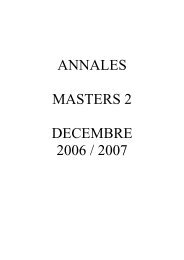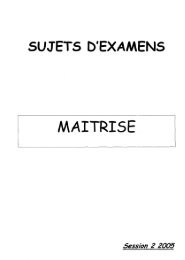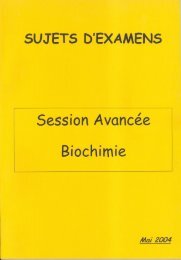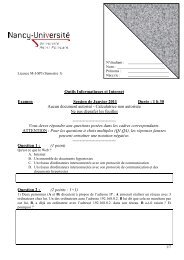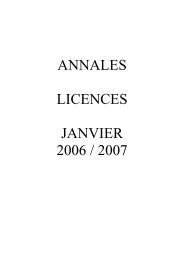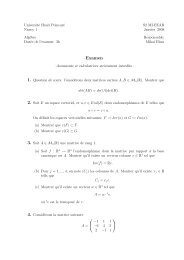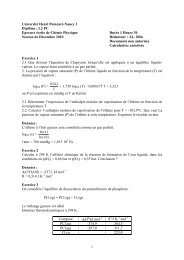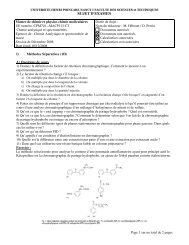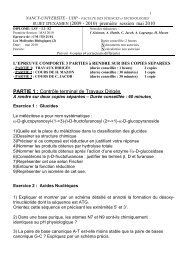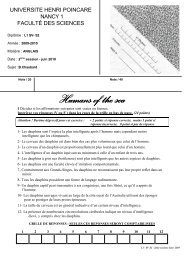Juin 2005
Juin 2005
Juin 2005
You also want an ePaper? Increase the reach of your titles
YUMPU automatically turns print PDFs into web optimized ePapers that Google loves.
Desperate to join in, urban investors rentedland from impoverished smallholders andtumed it over to soya. Anla, the farming group30 that did the damageto Colonia Loma Senés,henefited from such schemes.By 2002 almost half ofArgentina'sarableland -11.6 million hectares - was planted withsoya, almost ail ofit GM, comparedwith just\5 37,700 hectaresofsoya in 1971.Soyamovedbeyond the Pampas into moreenvironmentally fragile areas, especiallyin thenorthem provinces ofChaco, Santiago deIEstero, Salta and Formosa. Not even Monsanto1Ct had imagined that the move into RoundupReady soya wouldbe so rapid.At firsteverything lookedrosy. From 1997to2002 the area under soya eultivation increasedby 75 per cent and yieldsincreasedby 173perAround half of Arqenüna'sarable land is new underGM soya culüvationeconomies consultant Charles Benbrook,5 cent (see Diagram,p 43). In the earlyyearsthere reportedthat Roundup Readysoya growers inwere also c1ear environrnental benefits, Soil Argentina were using more than twice as mucherosion declined, thanks to the no-till method,' jcherbicidc as conventional soya farmers, largelyand fanners moved from more damaging because ofunexpected problems with tolerantherbicides to glyphosate, widely regarded as weeds. He alsofoundthatthey were applying;0 one ofthe least tOXIC herbicides avatlable. glyphosatc more frequently than their USr:ven when world soy~ priees started to counterparts - 2.3 versus 1.3 applications adeclme as global supply mcreased,Argentinian');year. Sayingthat "historyshows us thatfanners continued to do weIl finaneially. excessive reliance on any single strategyofMonsanto progressively eut the priee of weed or insect management will fail in the;5 Roundup and by2oo1 il was sellingatless than long mn, in thefaceof ecological and genetichalfits 1996 pnce. Overall, Argentina's farmers responses", he advised Argentinian farmers tomade a profit of about $5 billionby adopting .'Meduce their Roundup Readyacreageby asRoundup Ready soya.mueh as halfin order to eut glyphosate usage.Sorne years ago, however, a fewIfthey did not, he wamed, they would run the(,(2 agronomists started ta sound alarm bells, risk ofserious problems. Among hisw~~ng that the wholesale and unmonitored predictions were shifts in the composition ofshtft mto Roundup Ready soya was causing ('I{~:i"Weed speeies, the emergence ofresistantunforeseen problems. In a.study published in superweeds, ~d changes in sail microbiology.2001by theNorthwest SCIence andThe wammgfellon deaf ears, Argentina'sL ~ Envir~n~en~l Poltcy C:enter, a non-profit economy was in deep trouble, and with soyaorgarusation ln Sandpomt, Idaho, agricultural now i15 main export earner the govcmrnent"History shows us that excessive relianceon any single strategy ofweed orinsectmanagement will fail inthe long run, inthe face ofecological and genetic responses"was in no mood to intervene. The area under '!JeRoundupReady has continuedto grow, andfarmers hurt by the collapse ofArgentina'scu~cy. at the end of2001 are increasinglymovmg mto soya monoculture, as other cropsfor the domestic market have become t tj Sunprofitable. Glyphosate use continues to rise.Pengue estimates consumption reached150millionlitresin 2003, up fromjust 13.9million litresin 1997.Initially Pengue believed that with careful 2.v&rotation ofcrops and adequate controls overthe way the herbicide was applied, the moveto glyphosate would benefit the envîronment.But he is now concerned that the unmonitoreduse ofthis one herbicide is leading to the LuSproblemspredictedby Bcnbrook. In a studyinto the impact ofRoundup Ready soya Onweeds, Delma Faccini ofthe NationalUniversity ofRosario found that severalpreviously uncommon speeies ofglyphosate- i-j (Jtolerant weed had increased in abundance. Inanother study, agronomists from INTA's officein Venado Tuerto, near Rosario, found thatfarmers were having to use higherconcentrations ofglyphosate. Fornow, the /.15problem appears to be Iimited to theproliferation ofweeds that are naturallyresis~~t, but sorne agronomists are wamingthat rt ISonly a matter oftime beforeglyphosate resistance is transferred to other ).}. vweed species, turning them into superweeds.The third problem that was predicted byBenbrook-changes in soil microbiology.a1soappears to he happening. "Because somuch herbicide is being used, soil bacteria 1.;2.'5are declining and the soit is becoming inert,which is inhibiting the usuai process ofdecomposition," says agronomist Adolfo Boyfrom the Grupo de ReflexionRural, a groupofagronorrusts opposed to GM farming. "In 2.:,..::sorne fanns the dead vegetation even has tohe brushedoff the land."He alsohelievesthat slugs, snails and fungi are moving intothe newlyavailableecologicalniche.Roundup iswidely recognised asone ofthesafestherbicides available, but has spraying gotoutofhand?42NewSdenlist t7AjxiI2004www.newscienlisl.com_ •.2.-



